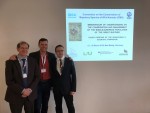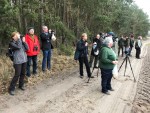Actions Agreed to Protect Europe’s Heaviest Flying Bird

Great Bustard © Franz Kovacs, LIFE Project "Great Bustard" www.grosstrappe.at
PRESS RELEASE
Bad Belzig, 15 March 2018 - Delegates from 13 countries agreed today on transboundary conservation measures for the Middle-European population of the Great Bustard. Germany is one of the signatories to a special agreement concluded under the Convention on Migratory Species (CMS, also known as the Bonn Convention) to better protect the species. CMS and the Brandenburg State Office for Environment (LfU) organized the meeting with support from the Förderverein Großtrappenschutz e.V. (Society for the Protection of the Great Bustard).
The globally threatened species prefers the open landscapes. Therefore, the best habitat for Great Bustard in Central Europe is open, unfragmented and non-intensively used agricultural fields with a high proportion of fallow land.
Intensive agriculture and infrastructure projects have been the main cause of the decline of Great Bustard populations. Barriers such as afforested areas, shelter belts, railways, roads and fences tend to fragment their habitats. The Great Bustard’s tendency to make low and short-distance flights makes it difficult for the birds to avoid such hazards. The construction of new highways and railways poses risks of fatal injuries. Many birds collide with power lines, the most significant cause of mortality in bustard species worldwide. All infrastructure measures should be subject to environmental impact assessments so that viable alternatives can be considered.
Existing power lines across Great Bustard areas should be buried or marked prominently to reduce mortality. Austria and Hungary have successfully installed power lines underground. Great Bustards may also collide with wind turbines. Disturbance drives the birds from ideal breeding and feeding habitats. Reduced breeding success, changes in habitat and lethal injuries from collisions decrease survival chances of populations. Without appropriate conservation and management measures, these combined threats will result in an overall population decline.
Great Bustards need protection from disturbance and other threats. Protected areas, strong legislation, less intensive farming without use of pesticides, and prior assessments to evaluate the environmental consequences of proposed plans are the building blocks of the new guidelines that have been adopted.
The birds require immediate action to better protect their breeding sites from agricultural activities or other disturbances. Collecting and analyzing data of ecologically significant areas help to minimize conflicts. Monitoring will provide more information on movements and mortality factors.
A scientific symposium preceded the meeting with expert contributions on current research, conservation and future reintroduction projects. The new findings will be fed into the European Great Bustard Species Action Planto mitigate threats and provide safe habitats.
For interviews or to speak to an expert, please contact:
Florian Keil, Coordinator of the Joint Communications Team at the UNEP/CMS and UNEP/AEWA Secretariats, Tel: +49 (0)228 8152451
Veronika Lenarz, Public Information, UNEP/CMS Secretariat, Tel: +49 (0)228 -8152409 Email: [email protected] www.cms.int
Last updated on 19 April 2018











